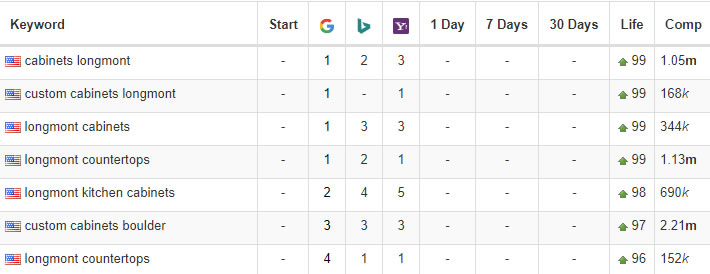Step 1: Finding the Right SEO Keywords
In the past post, we looked at how to improve traffic and increase rankings with a few simple steps: Step 1: Find the right keywords, Step 2: Use your keywords, Step 3: Track what you’re doing. Now we’ll dig deeper into how to find the right keywords.

Topic Buckets
First, select relevant keywords for your business by finding and analyzing keywords that people type into search engines. You’ll come up with 5-10 topic buckets that apply to your business. Try thinking like a customer. What would a customer type in to search for you? These are general topics that are relevant to your business—perhaps it’s questions that people have about your business or what your business offers customers. These “buckets” vary depending on your business. Also pay attention to the number of results (aka search volume) for each of these general topics—this is how important the topic is to your audience.
List of Keywords
Now that you have a list of topics, focus on some relevant keywords for some of those topics. These are the keywords that you think customers are searching and that likely rank well in SERP (Search Engine Results Pages). Search Engine Results Pages (SERP) refers to the pages displayed by search engines in response to a user’s search. Don’t worry, this isn’t your final list—it’s only a brainstorm at this point. Once you have a list, it’s time to pull in a tool to help determine what keywords you’ll rank well for. Plenty of tools are available and many are free. Do a bit of research and find the best tool for you.
If you use Google Analytics or another traffic measuring tool, you can use this to identify the keywords that customers use to reach your site. Do this for each bucket topic to generate a list of potential keywords.
Keyword Research
You now have a list of potential keywords, but it’s time to test these keywords. Head to Google and type in some of your potential keywords to see what comes up. You can also look at the related search terms at the bottom of the page. Sometimes these will spark some ideas for your list. Plus, you can click on competitors and see what their related search terms are as well.
Mix it up
Latent semantic indexing (LSI) refers to the system search engines use to analyze the other words people use surrounding a given topic. LSI keywords are words and phrases with a high degree of correlation to your target topic…kind of like a synonym. Google’s search algorithm uses them to help determine content quality and relevance to the search term. Search for a keyword in Google and then scroll to the bottom of the page–these are LSI keywords. Try researching some of these if you want to mix it up.
Research your Competition
Don’t feel like you have to copy what your competitors are doing. If a keyword is important to your competitors, it doesn’t have to be one of your keywords. However, you can look at competitors keywords to see what searches are important to them and how they’re ranking. You and your competition can have some of the same keywords…you can always improve your rankings for these. If there’s an obscure keyword that your competitor isn’t focused on, perhaps this is an opportunity for your business. Look at focusing on that!
Narrow the list
Now that you have a keyword list, it’s time to narrow it down. You can use a tool to help you do this. There are plenty of options available! For example, Google Trends and Google AdWords Keyword Planner can help you analyze search volume and traffic for potential keywords. While you don’t have to have a paid Google ad to use Keyword Planner, you’ll need to set up an account. Use the Keyword Planner to determine search volume. You don’t want words that have too little or too much search volume. Focus on the keywords that are somewhere in the middle. Before you write off some words, look at their projections and trend history in Google Trends and determine if they have potential. It’s not necessary to have 100s of target keywords for your optimization. Most of the time you only need 3 to 5 target phrases…these are better than none or 1000.
See, finding keywords isn’t too complicated, right? Now that we have a list of the right keywords, the next post will focus on what to do with those keywords. In the meantime, feel free to reach out to us if you have any SEO questions.

